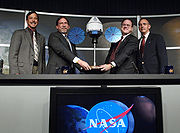NASA's future
It is the current space policy of the United States that NASA, "execute a sustained and affordable human and robotic program of space exploration and develop, acquire, and use civil space systems to advance fundamental scientific knowledge of our Earth system, solar system, and universe."'s ongoing investigations include in-depth surveys of Mars and Saturn and studies of the Earth and the Sun. Other NASA spacecraft are presently en route to Mercury and Pluto. With missions to Jupiter in planning stages, NASA's itinerary covers over half the solar system.
An improved and larger planetary rover, Mars Science Laboratory, is under construction and slated to launch in 2011, after a slight delay caused by hardware challenges, which has bumped it back from the October 2009 scheduled launch.[14] The New Horizons mission to Pluto was launched in 2006 and will fly by Pluto in 2015. The probe received a gravity assist from Jupiter in February 2007, examining some of Jupiter's inner moons and testing on-board instruments during the fly-by. On the horizon of NASA's plans is the MAVEN spacecraft as part of the Mars Scout Program to study the atmosphere of Mars.
Vision for space exploration
On January 14, 2004, ten days after the landing of the Mars Exploration Rover Spirit, US President George W. Bush announced a new plan for NASA's future, dubbed the Vision for Space Exploration. According to this plan, mankind will return to the Moon by 2018, and set up outposts as a testbed and potential resource for future missions. The Space Shuttle will be retired in 2010 and Orion will replace it by 2015, capable of both docking with the International Space Station (ISS) and leaving the Earth's orbit. The future of the ISS is somewhat uncertain – construction will be completed, but beyond that is less clear. Although the plan initially met with skepticism from Congress, in late 2004 Congress agreed to provide start-up funds for the first year's worth of the new space vision.
Hoping to spur innovation from the private sector, NASA established a series of Centennial Challenges, technology prizes for non-government teams, in 2004. The Challenges include tasks that will be useful for implementing the Vision for Space Exploration, such as building more efficient astronaut gloves.
Mission statement
From 2002, NASA’s mission statement, used in budget and planning documents, read: “To understand and protect our home planet; to explore the universe and search for life; to inspire the next generation of explorers ... as only NASA can.” In early February 2006, the statement was altered, with the phrase “to understand and protect our home planet” deleted. Some outside observers believe the change was intended to preserve the civilian nature of the agency, while others suspected it was related to criticism of government policy on global warming by NASA scientists like James Hansen. NASA officials have denied any connection to the latter, pointing to new priorities for space exploration. The chair and ranking member of the U.S. Senate Committee on Homeland Security and Governmental Affairs wrote NASA Administrator Griffin on July 31, 2006 expressing concerns about the change. also canceled or delayed a number of earth science missions in 2006.
Moon base
On December 4, 2006, NASA announced it was planning to build a permanent moon base. Associate Administrator Scott Horowitz said the goal was to start building the moonbase by 2020, and by 2024, have a fully functional base, that would allow for crew rotations and in-situ resource utilization. Additionally, NASA plans to collaborate and partner with other nations for this project.

 6:03 AM
6:03 AM
 Nasa Information
,
Nasa Information
,



0 Response to "NASA's future"
Post a Comment